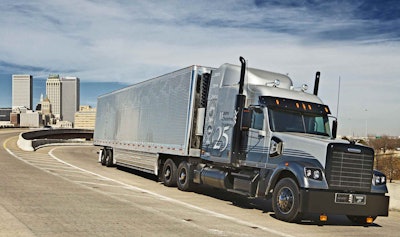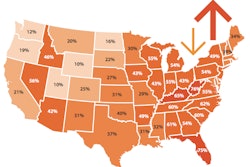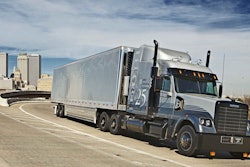
Load One expediter Tom Evans drives team with his wife, Tina, running a three-truck Class 8 straight truck fleet based in Mattoon, Ill. Besides their compensation for doing their jobs the right way, the Evans duo is eligible for additional perks for the same reason.
Load One uses a driver rewards program called Stay Metrics that takes data gleaned from surveys of drivers during their first weeks with the carrier to help predict which ones are at risk of leaving. The system builds on that relationship with a program that allows drivers to earn points redeemable for merchandise.
CLICK HERE OR THE INFOGRAPHIC TO SEE A LARGER VERSION |
“The biggest thing is simply getting rewards for doing something that’s no more than what you’re already supposed to be doing,” such as turning in logs on time and completing surveys, Tom Evans says.
The pace of available information and data gathering in trucking is accelerating, and with it, more companies to manage that data for fleets — and more unique ways to solicit it.
In this new era of statistics, a handful of vendors offering predictive analytics and cutting-edge data interpretation have emerged. They’re helping fleets crunch mountains of information to spot broad patterns and take pre-emptive action with individual drivers to improve retention and safety. The results so far have been impressive.
Predictive modeling remains relatively new in trucking, and while no major complaints have emerged within the industry, broader concerns over privacy or misapplication of data-based conclusions have been voiced elsewhere.
One major fleet using a predictive analytics company expressed such concerns. The fleet’s media contact, declining an interview request, wrote that, “It’s a topic we aren’t eager to talk publicly about due to its tendency to be used in litigation.”
An expert in the field says he’s unaware of actual litigation based strictly on predictive modeling practices. Still, there has been controversy, says Eric Siegel, founder of the Predictive Analytics World conference series and author of “Predictive Analytics.”
Much of the concern has stemmed from publicity over telephone eavesdropping by the National Security Agency. Yale law professor Jack Balkin, writing about NSA’s data mining, says such activities “allow the state and business enterprises to record perfectly innocent behavior that no one is particularly ashamed of and draw surprisingly powerful inferences about people’s behavior, beliefs and attitudes.”
One striking inference was contained in a 2012 New York Times article that led to further coverage on major TV talk shows. The story described how Target uses not only baby registration data but also purchasing data to direct its marketing efforts to women it believes are pregnant.
The story, with “a tone that implies wrongdoing,” wrote Siegel in his book, “punctuates this by alleging an anonymous story of a man discovering his teenage daughter is pregnant only by seeing Target’s marketing offers to her.”
In trucking, the impetus to use predictive analytics isn’t to sell products, but rather to show whether a driver is about to leave the company or have an accident. As for improving safety, whether in trucking or any field, ethical concerns “are few and none,” says Siegel. “There’s a lot of potential to do a lot of good.”
But when it comes to concerns over companies using data to reveal personal problems that could affect loyalty or performance, “There are places where the world is not comfortable with that yet,” he says.
Perhaps the most publicized human resources application of predictive analytics involves Hewlett-Packard. In 2011, two HP scientists analyzed data on more than 330,000 company employees to measure each one’s “flight risk,” or chance of quitting.
The intention is to help managers prevent good employees from leaving. Siegel reports the program has had modest success at HP.
Still, there can be problems, as he points out: “What if your score is wrong, unfairly labeling you as disloyal and blemishing your reputation?”
Here the application to trucking is more direct. With turnover rates so high, predictive analytics could become a major tool.
So far, predictive analytics’ use in human resources largely has held to the high road, say Siegel and those involved with it in trucking.
“We’re not peering into drivers’ personal lives,” says Vikas Jain, general manager of Omnitracs Analytics. (Since this report was originally published, Jain has left Omnitracs Analytics.) “We’re not accessing any data the fleet doesn’t already have. We are helping the driver.”
| Click here to listen to a podcast of predictive analytics expert Eric Siegel discussing the ethics of predictive modeling and its safety and human resources applications for trucking |
Still, the process can involve identifying driver stresses that are unrelated to trucking. However, no major complaints stemming from fleets using predictive modeling have come from members of the Owner-Operator Independent Drivers Association, says spokesman Norita Taylor.
Here is a look at vendors that take varied approaches to the same problems and serve differing niches of fleets by size. They are leaders in helping fleets use data, to varying degrees with predictive modeling, to improve retention, safety or both.
No. 1 — Omnitracs Analytics (formerly FleetRisk Advisors)
Other predictive analytics leaders: Lytx, SmartDrive, Transportation Performance













